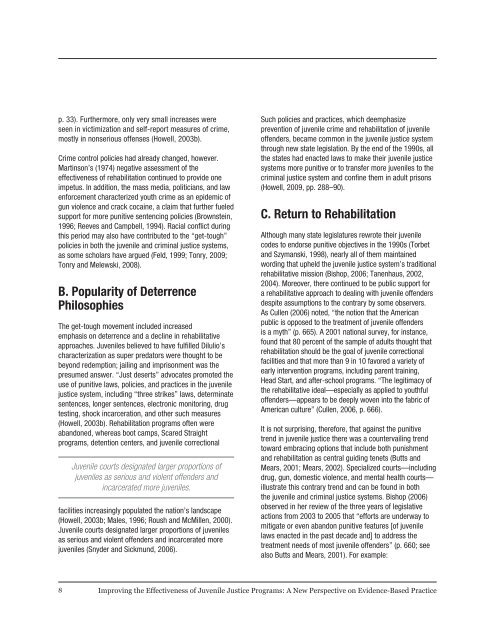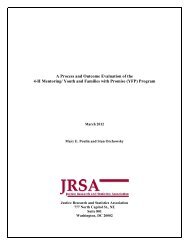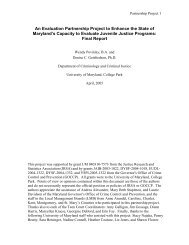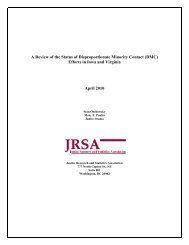Improving the Effectiveness of Juvenile Justice Programs: A New
Improving the Effectiveness of Juvenile Justice Programs: A New
Improving the Effectiveness of Juvenile Justice Programs: A New
Create successful ePaper yourself
Turn your PDF publications into a flip-book with our unique Google optimized e-Paper software.
p. 33). Fur<strong>the</strong>rmore, only very small increases were<br />
seen in victimization and self-report measures <strong>of</strong> crime,<br />
mostly in nonserious <strong>of</strong>fenses (Howell, 2003b).<br />
Crime control policies had already changed, however.<br />
Martinson’s (1974) negative assessment <strong>of</strong> <strong>the</strong><br />
effectiveness <strong>of</strong> rehabilitation continued to provide one<br />
impetus. In addition, <strong>the</strong> mass media, politicians, and law<br />
enforcement characterized youth crime as an epidemic <strong>of</strong><br />
gun violence and crack cocaine, a claim that fur<strong>the</strong>r fueled<br />
support for more punitive sentencing policies (Brownstein,<br />
1996; Reeves and Campbell, 1994). Racial conflict during<br />
this period may also have contributed to <strong>the</strong> “get-tough”<br />
policies in both <strong>the</strong> juvenile and criminal justice systems,<br />
as some scholars have argued (Feld, 1999; Tonry, 2009;<br />
Tonry and Melewski, 2008).<br />
B. Popularity <strong>of</strong> Deterrence<br />
Philosophies<br />
The get-tough movement included increased<br />
emphasis on deterrence and a decline in rehabilitative<br />
approaches. <strong>Juvenile</strong>s believed to have fulfilled DiIulio’s<br />
characterization as super predators were thought to be<br />
beyond redemption; jailing and imprisonment was <strong>the</strong><br />
presumed answer. “Just deserts” advocates promoted <strong>the</strong><br />
use <strong>of</strong> punitive laws, policies, and practices in <strong>the</strong> juvenile<br />
justice system, including “three strikes” laws, determinate<br />
sentences, longer sentences, electronic monitoring, drug<br />
testing, shock incarceration, and o<strong>the</strong>r such measures<br />
(Howell, 2003b). Rehabilitation programs <strong>of</strong>ten were<br />
abandoned, whereas boot camps, Scared Straight<br />
programs, detention centers, and juvenile correctional<br />
<strong>Juvenile</strong> courts designated larger proportions <strong>of</strong><br />
juveniles as serious and violent <strong>of</strong>fenders and<br />
incarcerated more juveniles.<br />
facilities increasingly populated <strong>the</strong> nation’s landscape<br />
(Howell, 2003b; Males, 1996; Roush and McMillen, 2000).<br />
<strong>Juvenile</strong> courts designated larger proportions <strong>of</strong> juveniles<br />
as serious and violent <strong>of</strong>fenders and incarcerated more<br />
juveniles (Snyder and Sickmund, 2006).<br />
Such policies and practices, which deemphasize<br />
prevention <strong>of</strong> juvenile crime and rehabilitation <strong>of</strong> juvenile<br />
<strong>of</strong>fenders, became common in <strong>the</strong> juvenile justice system<br />
through new state legislation. By <strong>the</strong> end <strong>of</strong> <strong>the</strong> 1990s, all<br />
<strong>the</strong> states had enacted laws to make <strong>the</strong>ir juvenile justice<br />
systems more punitive or to transfer more juveniles to <strong>the</strong><br />
criminal justice system and confine <strong>the</strong>m in adult prisons<br />
(Howell, 2009, pp. 288–90).<br />
C. Return to Rehabilitation<br />
Although many state legislatures rewrote <strong>the</strong>ir juvenile<br />
codes to endorse punitive objectives in <strong>the</strong> 1990s (Torbet<br />
and Szymanski, 1998), nearly all <strong>of</strong> <strong>the</strong>m maintained<br />
wording that upheld <strong>the</strong> juvenile justice system’s traditional<br />
rehabilitative mission (Bishop, 2006; Tanenhaus, 2002,<br />
2004). Moreover, <strong>the</strong>re continued to be public support for<br />
a rehabilitative approach to dealing with juvenile <strong>of</strong>fenders<br />
despite assumptions to <strong>the</strong> contrary by some observers.<br />
As Cullen (2006) noted, “<strong>the</strong> notion that <strong>the</strong> American<br />
public is opposed to <strong>the</strong> treatment <strong>of</strong> juvenile <strong>of</strong>fenders<br />
is a myth” (p. 665). A 2001 national survey, for instance,<br />
found that 80 percent <strong>of</strong> <strong>the</strong> sample <strong>of</strong> adults thought that<br />
rehabilitation should be <strong>the</strong> goal <strong>of</strong> juvenile correctional<br />
facilities and that more than 9 in 10 favored a variety <strong>of</strong><br />
early intervention programs, including parent training,<br />
Head Start, and after-school programs. “The legitimacy <strong>of</strong><br />
<strong>the</strong> rehabilitative ideal—especially as applied to youthful<br />
<strong>of</strong>fenders—appears to be deeply woven into <strong>the</strong> fabric <strong>of</strong><br />
American culture” (Cullen, 2006, p. 666).<br />
It is not surprising, <strong>the</strong>refore, that against <strong>the</strong> punitive<br />
trend in juvenile justice <strong>the</strong>re was a countervailing trend<br />
toward embracing options that include both punishment<br />
and rehabilitation as central guiding tenets (Butts and<br />
Mears, 2001; Mears, 2002). Specialized courts—including<br />
drug, gun, domestic violence, and mental health courts—<br />
illustrate this contrary trend and can be found in both<br />
<strong>the</strong> juvenile and criminal justice systems. Bishop (2006)<br />
observed in her review <strong>of</strong> <strong>the</strong> three years <strong>of</strong> legislative<br />
actions from 2003 to 2005 that “efforts are underway to<br />
mitigate or even abandon punitive features [<strong>of</strong> juvenile<br />
laws enacted in <strong>the</strong> past decade and] to address <strong>the</strong><br />
treatment needs <strong>of</strong> most juvenile <strong>of</strong>fenders” (p. 660; see<br />
also Butts and Mears, 2001). For example:<br />
8 <strong>Improving</strong> <strong>the</strong> <strong>Effectiveness</strong> <strong>of</strong> <strong>Juvenile</strong> <strong>Justice</strong> <strong>Programs</strong>: A <strong>New</strong> Perspective on Evidence-Based Practice

















